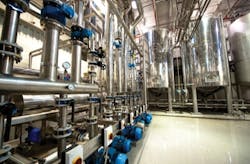Anaerobic Digestion System to Provide Pipeline Quality Gas
In 2008, 31% of Québec's municipal wastewater sludge ended up in landfills. By 2020, Quebec wants to divert all residual materials from landfills in order to recycle, produce energy or dispose of the waste, in that order.
To reach this goal, Québec recently adopted a series of policies and programs as part of the government's sustainable development strategy. The Green Infrastructure Fund of Québec earmarked Cnd $650 million for municipalities to divert organic materials away from landfills. This new approach promotes the emergence of a green economy based on the environment and quality of life for its citizens through a zero-waste policy.
The City of Saint-Hyacinthe received some of this "green money" to expand its existing wastewater treatment plant (WWTP) and produce pipeline quality biomethane. Saint-Hyacinthe currently has three digesters (1,600 m³ ea.) with a capacity of 36 tons of solids per day (13,000 dried tons/year). Seventy-three thousand tons per year of sewage sludge are pumped towards the digestion tanks from the primary and secondary sedimentation tanks which are heated from 10°C to 37°C. With the new funding, the city now can start Phase II of the upgrade: construction of two hydrolysers (1,200 m³ each) and three more digesters (1,800 m³ each) with Montreal based renewable energy company Bio-Methatech.
Currently, the city uses the WWTP's biogas to dry the sludge that comes out of the digesters. This reduces the overall waste by 85 percent and results in a clean, light, granular, Class A biosolid that is safe and beneficial for agricultural, horticultural, municipal and domestic use.
"Before the treatment facility was in place, the city hauled 13,500 tons of treated sewage every year to a landfill where tipping fees averaged an expensive $90 a ton. Plus, the 100 kilometer round trip burned a lot of fuel," said Pierre Mathieu, Head of the Division of Waste Water Treatment in the town of Saint-Hyacinthe.
In Phase II, instead of just using the digesters, the WWTP will first route the biosolids through the hydrolyzers to break down the cell structure and organic material. Operators will also add cheese whey and other organic waste to boost the production of biogas from the anaerobic digestion process.
To further boost biogas production and make the flow of gas more consistent, the WWTP chose a sidewall entry mixer to properly mix each digester and maintain a good distribution of temperature, pH levels and micro-organisms. A single SUMA Giantmix FR4 mixer will generate a circular flow in the tank to promote maximum digestion and a flow pattern which allows heavier solids to settle to the bottom of the digester. At the bottom, the digester tank has a special drain where heavy solids are removed without shutting down biogas production.
The mixer also has two unique features which allow a visual assessment of the agitators' condition and will cut fibrous components that tend to adhere to propeller blade edges. For a visual assessment, operators can use the external oil inspection glass to detect seal breaks, oil contamination and shaft bending in the equipment. A cutting blade located behind the propeller is especially effective in cutting away troublesome fibrous materials.
"When you add organics to wastewater you boost your biogas production but create new, unknown variables," said Christie Allen, International Business Development Manager at SUMA GmbH. "Plant type, length and size of fiber will change the viscosity based on which organics are added each season. It's important to monitor the equipment and monitor the dry matter content of the substrate. As maintenance personnel learn the impact of these materials on the digester, they can simply adjust the agitator speed of the mixer to optimize biogas production."
In the next year, after Phase II, surplus biogas will be upgraded to biomethane and injected into the natural gas distribution grid operated by Gaz Métro. Gaz Métro anticipates selling 4-5 million m³ of biomethane each year (460-570 m³/hour) for the city's buildings, natural gas vehicles and the gas network.
Currently, the Saint-Hyacinth digesters produce 150 m³/hour of biogas which is equivalent to 3 MBtu/hour of energy and 350 kWh electricity. Adding organic waste with the additional capacity, Bio-Methatech expects the WWTP to produce 1,200 m³/hour of biogas, 26 MBtu/hour of energy and 3,000 kWh electricity 8.5 times more energy using co-substrates then with only the municipal sludge.
The City of Saint-Hyacinthe is in an ideal location to install the biomethane system as the WWTP is located near a Gaz Métro pipeline.
"This project with the City of St. Hyacinthe is the future. Traditionally, wastewater facilities use more energy than any other part of the city, but each one should produce energy—biogas—from the organic waste in our sewers, restaurants and yards. Then they can use biogas to produce electricity or upgrade it to biomethane, a renewable substitute for natural gas," said Patrick Serfass, Executive Director of the American Biogas Council.
"Today, the US has over 2,200 operational anaerobic digesters. The majority, 1,500, are located at wastewater treatment plants, but only a scant 250 currently use the biogas they generate. This means 1,250 biogas-producing WWTPs could be producing biomethane or electricity, and then there are another 2,000 WWTPs that are completely undeveloped. This is a massive economic opportunity."
Montreal-based Bio-Méthatech is a joint venture involving the family-owned Dominion & Grimm Inc. - suppliers of equipment to maple syrup producers - and waste management company RCI. The company has the license to represent and manufacture LIPP KomBio digesters, a German company that has over 500 biogas installations worldwide. In Canada and the Northeastern U.S five new LIPP digesters will be built by Bio-Methatech and starting in the fall of 2012.
SUMA America Inc. is an exclusive distributor for SUMA GmbH; a mixing manufacturer specializing in agitation equipment for fermentation-gas (biomethane) plants, tanks or lagoons. SUMA America has over a dozen installations throughout Canada and the USA.
More WaterWorld Current Issue Articles
More WaterWorld Archives Issue Articles

